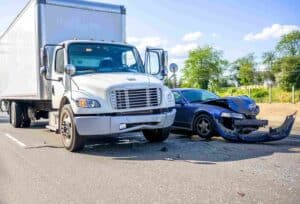
- Vaughn A. Wamsley
- Truck Accidents
Driving on Indiana’s highways often means sharing the road with big trucks—18-wheelers, semis, and other large commercial vehicles. These massive machines are essential to commerce, but they also pose serious risks to smaller vehicles. As an accident lawyer in Carmel, we have helped many victims recover after devastating crashes with big rigs. We know how life-changing these accidents can be.
That is why we believe prevention is just as important as representation. In this blog, we want to share practical, actionable tips to help you stay safe when driving around large trucks. We also want to educate you on your rights if something goes wrong. With the right information and a little caution, you can significantly reduce your risk of a serious accident.
Why Big Trucks Are More Dangerous Than Other Vehicles
Large trucks weigh up to 80,000 pounds when fully loaded—20 to 30 times more than a standard car. They require more time and distance to stop, and they have multiple blind spots that can easily hide a full-size vehicle. According to the Federal Motor Carrier Safety Administration (FMCSA), about 4,998 large trucks were involved in fatal crashes across the U.S. in 2020. In Indiana alone, nearly 5,000 truck-related crashes were reported in 2023.
Due to their size and power, big rigs cause more severe injuries and fatalities than other vehicles when crashes occur. In fact, 72% of people killed in truck crashes are occupants of other vehicles, not the truck itself. The margin for error is small when you are near one of these vehicles.
Key Safety Tips for Driving Around Big Trucks
Here are our top safety recommendations for Indiana drivers sharing the road with big trucks:
1. Stay Out of Blind Spots
Big trucks have large “no-zones,” or blind spots, on all four sides:
- 20 feet in front of the truck
- 30 feet behind the truck
- One lane wide on the left side
- Two lanes wide on the right side
The truck driver may not see you if you are in any of these zones. A good rule is: If you cannot see the truck’s side mirrors, the driver cannot see you either. Always avoid lingering in blind spots and move through them quickly and safely.
2. Maintain a Safe Following Distance
Rear-ending a semi-truck can be deadly. Because trucks have higher ground clearance, a car can slide underneath in a collision called an underride crash, which is almost always catastrophic.
In good conditions, give trucks at least four to five seconds of following distance. In rain, snow, or low visibility, increase that space even more. Remember, trucks take 40% longer to stop than cars.
3. Pass Trucks on the Left—Never the Right
Always pass on the left side. Truck drivers expect you to do so, and visibility is better. Passing on the right puts you in the truck’s largest blind spot and increases your risk of being sideswiped or run off the road.
When you pass, do it promptly and smoothly. Do not hang out alongside the truck. Accelerate, pass, and return to your lane only when you can see the truck’s entire front in your rearview mirror.
4. Do Not Cut Off a Truck
It may be tempting to merge in front of a truck to avoid slowing down, but this is extremely dangerous. Trucks cannot stop quickly, and cutting in front of one could cause a rear-end collision that pushes your car into other traffic or off the road.
Leave plenty of room. A truck moving at 65 mph needs the length of two football fields to come to a complete stop. Merging too soon can be deadly.
5. Use Caution When a Truck is Turning
Trucks make wide turns, especially right turns. They may need to swing left before turning right, which can confuse other drivers. Never try to squeeze between a turning truck and the curb. You could get pinned, crushed, or struck by a trailer swinging around the corner.
If you see a truck preparing to turn, slow down and give it room. Expect unusual movement, and be patient.
6. Adjust for Bad Weather
In poor weather conditions, the risk of a truck crash increases. High winds can cause trailers to sway or even tip. Snow and ice can drastically reduce traction. Rain can decrease visibility and cause hydroplaning.
During bad weather, increase your following distance, reduce speed, and avoid abrupt maneuvers near trucks. If conditions are especially bad, consider pulling over until visibility improves.
7. Avoid Distracted Driving
This applies to any driving situation but is particularly critical around big rigs. Looking at your phone, adjusting the radio, or eating while driving can cause you to miss the signs of a truck slowing down, changing lanes, or swinging wide to turn. Stay focused and alert at all times.
8. Watch for Tired or Aggressive Truckers
Though most truck drivers are professionals who follow the rules, some may drive while fatigued or under pressure to meet deadlines. Others may tailgate, speed, or drive aggressively.
Stay clear if you see a truck weaving, braking erratically, or drifting between lanes. Report unsafe drivers to the Indiana State Police or call 911 if necessary.
Indiana Trucking Laws You Should Know
Indiana law requires commercial truck drivers to follow both state and federal regulations, including:
- Maximum hours of service (HOS): Drivers may not exceed 11 hours of driving after 10 consecutive hours off duty.
- CDL requirements: All truck drivers must hold a valid commercial driver’s license.
- Truck inspections: Vehicles must be regularly inspected and maintained.
- Liability coverage: Trucks must carry higher insurance limits than passenger vehicles, often $750,000 or more.
If a truck driver violates these laws and causes an accident, they may be found negligent. As a Carmel truck accident attorney, we use these violations to build strong injury claims for our clients.
Who Is Liable in a Truck Accident in Indiana?
Truck accident cases are complex because multiple parties may be at fault, including:
- The truck driver
- The trucking company
- A third-party maintenance contractor
- The company that loaded the cargo
- The manufacturer of a defective truck part
We work to identify every liable party. This gives our clients the best chance at maximum compensation, especially in cases involving catastrophic injuries.
Indiana’s Comparative Fault Rule
Indiana follows a “modified comparative fault” rule (Indiana Code § 34-51-2). This means you can recover damages even if you were partly at fault, so long as you are not more than 50% responsible. Your percentage of fault will reduce your compensation.
For example, if you were awarded $100,000 but found 20% at fault, you would receive $80,000.
Statute of Limitations for Truck Accident Claims
Indiana law gives you two years from the date of your truck accident to file a lawsuit (Indiana Code § 34-11-2-4). This applies to personal injury and wrongful death claims. You may lose your right to seek compensation entirely if you miss this deadline.
We recommend contacting an accident lawyer in Carmel as soon as possible. The earlier we begin working on your case, the more evidence we can gather to support your claim.
What To Do After a Truck Accident
If you are involved in a crash with a big rig, take the following steps:
- Call 911 immediately
- Get medical attention
- Do not admit fault
- Take photos of the scene, your vehicle, and injuries
- Get contact information for the driver, witnesses, and company
- Do not talk to the trucking company’s insurance adjuster without legal counsel
- Contact our big rig wreck law firm in Carmel, IN
Why Choose Us

When you hire a truck accident lawyer in Carmel from our team, you can expect:
- A thorough investigation of your case
- Access to expert witnesses and accident reconstructionists
- Aggressive negotiation with insurers
- Honest advice and communication every step of the way
- Litigation support if your case goes to trial
We treat every case with the attention it deserves. You are not just a file number—you are a person who needs real help.
Frequently Asked Questions: Driving Around Big Trucks in Indiana
What should I do if I witness unsafe driving by a truck driver?
Report the incident immediately if you see a truck weaving, tailgating, speeding, or showing signs of driver fatigue. You can call 911 if the behavior presents a danger to others or contact the Indiana State Police Commercial Vehicle Enforcement Division at 317-615-7373. Note the truck’s license plate, company name, and location.
Are dashcams useful in truck accident cases?
Yes. Dashcam footage can provide critical evidence of what occurred before, during, and after the crash. This footage may help establish liability, especially in cases where the truck driver denies wrongdoing or if there were no witnesses. If you drive frequently near big trucks, investing in a quality dashcam is a smart precaution.
Can truck companies be held responsible for their drivers’ actions?
Often, yes. Under the legal doctrine of “respondeat superior,” employers can be held liable for the actions of their employees while on the job. If the trucking company fails to perform background checks, ignores hours-of-service violations, or fails to maintain the truck properly, it may share or even bear full liability for the crash.
Do truck drivers in Indiana undergo regular training?
Commercial truck drivers must complete training programs and obtain a Commercial Driver’s License (CDL). However, not all companies provide ongoing education. If a driver lacks proper training or has a history of safety violations, it could strengthen your claim against them and their employer.
Should I speak to the trucking company’s insurance adjuster?
No. Always speak with a Carmel truck accident attorney before giving any recorded statements. Insurers often try to minimize payouts by shifting blame or undervaluing your injuries. We can protect your rights and communicate on your behalf.
Stay Safe When Driving Around Big Trucks in Indiana
Big trucks are a daily reality on Indiana roads and are not going away anytime soon. The good news is that you can avoid most dangerous situations with awareness and a few smart driving habits. If the worst happens and you are hurt in a crash, we are here to guide you through the legal process and fight for the justice you deserve.
Contact us today to speak with an accident lawyer in Carmel. We offer free consultations and do not charge any fees unless we win your case. Let our Carmel truck accident attorney fight for you while you focus on healing.

